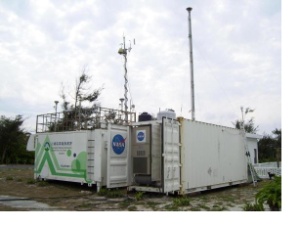EPA Monitoring Shows South China Sea Not Polluted
December 30, 2010
The Environmental Protection Administration (EPA) of the Executive Yuan said the first successful marine water quality monitoring it conducted in the Spratly Islands in September 2010 showed that water quality at all monitoring points around Taiping Island and Central Reef are qualified with Taiwan's A type standards of marine environmental quality, making it an unpolluted sea area.

The EPA inaugurated the Pratas Island Background Station in January 2009 and started monitoring the environmental quality in South China Sea, expanding Taiwan's long-term environmental monitoring area to South China Sea. (Photo: Business Wire)
It is quite difficult to conduct marine water quality monitoring around Central Reef because of its low-lying terrain and the sampling operation in 2009 was not accomplished because of bad weather, noted the EPA. After strengthening sampling personnel training and exercise as well as upgrading marine water quality sampling techniques, the EPA team accomplished the first successful sampling mission September 21-27, 2010, which represents a historical breakthrough in monitoring South China Sea water quality and expands again Taiwan's space for environmental monitoring.
The EPA inaugurated the Pratas Island Background Station in January 2009 and started monitoring the environmental quality in South China Sea, expanding Taiwan's long-term environmental monitoring area to South China Sea. The Pratas Island Background Station has participated in global background monitoring since it joined AERONET (Aerosol Robotic Network) of the U.S. NASA in September 2009.
As an outpost of Taiwan's environmental quality monitoring, the Pratas Island Background Station provides AERONET with vital first-hand information on regional air pollutants, thus increasing Taiwan's visibility in the international community. NASA has provided a set of advanced background air monitoring equipment to conduct joint monitoring from the Pratas Island and the National Museum of Marine Biology and Aquarium in Pingtung in cooperation with the EPA since January 2010, marking the beginning of Taiwan's participation in global joint monitoring.
This joint monitoring program has also combined research teams from Southeast Asian nations and Taiwan in implementing a 4-year environmental monitoring plan on such issues as man-made biomass burning and long-range transmission of air pollutants in Southeast Asia and South China Sea, atmospheric chemical features and global climate changes, collecting related environmental background data until 2013.
Because of the sandstorm in mainland China in March 2010, air quality throughout Taiwan were rated as unhealthful or worse and even Pratas Island, 450 km south of Kaohsiung, had detected air pollution, demonstrating the seriousness of air pollution's cross-border transmission and the importance of the joint monitoring program, said the EPA. The successful implementation of the monitoring program also proved that Taiwan's environmental monitoring techniques have been up to international standards, added the EPA.
Copyright Business Wire 2010